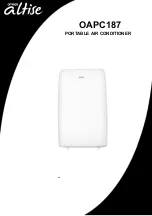
9
If the outdoor temperature is above 65 degrees F or higher:
Charge the system following the steps below:
1. With the system operating at steady state, measure the
superheat at suction line service valve for fixed orifice systems,
like P7RE-018K/024K/030K/036K/042K/ 048KA, or measure
the subcooling at the liquid service valve for TXV systems,
like P7RE X60 KA model.
2. Measure the outdoor dry bulb temperature ( F) and indoor
wet bulb temperature ( F).
NOTE:
The charging tables are on the inside of the unit’s
electrical control access panel. The tables provide superheat
targets for th e units with fixed orifice and subcooling targets
for TXV systems.
3. Adjust the charge to match the target superheat or target
subcooling.
4. The system should be charged so that the measured superheat/
subcooling is / 1 F of the target listed in the table.
For fixed orifice system:
• If your measured superheat at the suction valve is
LESS
THAN
the recommended superheat value in the table then
REMOVE
refrigerant.
• If your measured superheat at the suction valve is
GREATER
THAN
the recommended superheat value in the table then
ADD
refrigerant.
For TXV systems:
• If your measured subcooling at the liquid valve is
LESS THAN
the recommended subcooling value in the table then
ADD
refrigerant.
• If your measured subcooling at the liquid valve is
GREATER
THAN
the recommended subcooling value in the table then
REMOVE
refrigerant.
If the outdoor temperature is below 65 degrees F:
After leak checking the system, and evacuating the system,
perform the following steps:
1. weigh in the charge amounts recommended and printed on
the unit rating plate, the rating plate can be found on the
exterior panel of the unit.
2. Return to the system when the outdoor temperature is 65
degrees F or higher and follow the steps defined at “If the
outdoor temperature is 65 degrees F or higher” section above.
Safety switches
The high-pressure switch is factory-installed and located in the
liquid line internal to the unit. The switch is designed to protect
the system when very high pressures occur during abnormal
conditions. Under normal conditions, the switch is closed. If the
liquid pressure rises above 650 psig, the switch will open and
de-energize the unit. The switch will close again when the liquid
pressure decreases to 460 psig.
AIR CONDITIONER MAINTENANCE
WARNING:
To prevent electrical shock, personal injury, or
death, disconnect all electrical power to the unit
before performing any maintenance or service.
The unit may have more than one electrical
supply.
Proper maintenance is important to achieve optimum
performance from the air conditioner. The ability to properly
perform maintenance on this equipment requires certain
mechanical skills and tools. If you do not possess these skills,
contact your dealer for maintenance. Consult your local dealer
about the availability of maintenance contracts.
Routine maintenance should include the following:
• Inspect and clean or replace air filters at the beginning of each
heating and cooling season, or more frequently if required.
• Inspect the condensate drain and outdoor coil at the beginning
of each cooling season. Remove any debris. Clean the outdoor
coil and louvers as necessary using a mild detergent and
water. Rinse thoroughly with water.
• Inspect the electrical connections for tightness at the beginning
of each heating and cooling season. Service as necessary.
CAUTION:
The unit should never be operated without a
filter in the return air system. Replace disposable
filters with the same type and size.
• Do not add additional oil to motors unequipped with oil tubes.
The compressor is hermetically sealed at the factory and does
not require lubrication.
REFRIGERANT CHARGING
Charging the Unit
CAUTION:
This air conditioner contains liquid and gaseous
refrigerant under pressure. Adjustment of
refrigerant charge should only be attempted
by qualified, trained personnel thoroughly
familiar with the equipment and safe responsible
refrigerant handling procedures. Under no
circumstances should the homeowner attempt
to install and/or service this equipment. Failure
to comply with this warning could result in
equipment damage, personal injury, or death.
NOTE:
The refrigerant charge can be checked and adjusted
through the service ports provided external to the unit. Use
only gage line sets which have a “Schrader” depression device
present to actuate the valve.


































